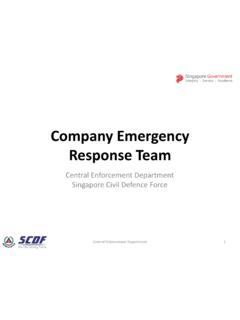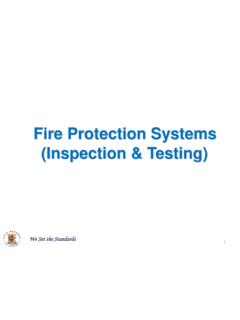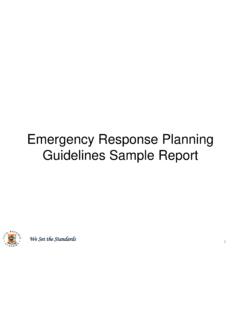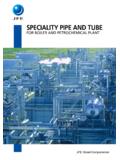Transcription of Fire Safety Guidelines for Open Plant Structures in Oil ...
1 Singapore Fire Safety Guidelines Fire Safety Guidelines for Open Plant Structures in Oil, Chemical and Process Industries 1st Jan 2011 Singapore Fire Safety Guidelines Fire Safety Guidelines for Open Plant Structures in Oil, Chemical and Process Industries All rights reserved. Unless otherwise specified, no part of this Guidelines may be reproduced or utilised in any form or by any means, electronic or mechanical, including photocopying and microfilming, without permission in writing from the Custodian of this document at the address below: Singapore Chemical Industry Council Limited (SCIC) 8 Jurong Town Hall Road, #25-04, The JTC Summit, Singapore 609434 Email: This Guidelines was approved by the management of Singapore Civil Defence Force (SCDF), Singapore Chemical Industry Council (SCIC) and the Oil and Petrochemical Industries Technical Safety Committee (OPITSC) on 1st Jan 2011.
2 First published in 12th Sep 2012 The Working Group for the Guidelines was appointed by the above Organisations to assist in the preparation of the Guidelines . The Working Group comprises the following persons who contribute their views and experiences gained as professions in their companies and in their individual capacities: Co-Chairmen Mr Lee Wee Keong Singapore Civil Defence Force Mr Wang Hui Hua Singapore Chemical Industry Council Limited Members Mr Louis Hwang Engineers 9000 Pte Ltd Mr Koh Soon Chuang Institution of Fire Engineers (Singapore) Mr Henry Lim/Mr Ng Kok Leong ExxonMobil asia Pacific Pte Ltd Mr hong Kim Pong Petrochemical Corporation of Singapore (Pte) Limited Mr Ho Chee Fook Shell Chemicals Seraya Pte Ltd Mr Low Teck Lye Singapore Refining Company MAJ Thng Ting Mong Singapore Civil Defence Force MAJ Han Fook Kwang Singapore Civil Defence Force Mr Teo Kah Boon (Secretary)
3 Singapore Chemical Industry Council Limited The Guidelines serve as an accepted fire Safety requirement for open Plant structure installation in Singapore. The Guidelines give Plant developers clearer scope of work, thus save time and efforts. Plant developers are encouraged to use the Guidelines for project planning, technical guidance and scheduling of their project work. The Guidelines however does not exclude any best practices that aim to achieve even higher fire Safety standards and other approach that Plant developers wish to proceed or mitigate without lower the standard of this Guidelines . However, such alternate approach would certainly take more time and efforts for both the Plant developer and the approving Authority as submission of studies and reviewing process for alternates are needed.
4 In short, the design and construction of the installation shall reduce fire Safety risks to the possible minimum level through adopting international good engineering design and practices, including reasonable security measures to be considered. Plant developer adopting the alternate approach shall justify the alternate proposal through submission of relevant studies to show consequences or risks taking are adequately covered and accepted by the relevant Competent Authorities. 2 Content 1. Overview Purpose Philosophy and Consideration Design Objectives Process Hazard Review 2. Scope of Fire Safety Layout and Spacing Drainage Isolation, Deinventory and Depressurizing of Plant Means of Escape Passive Fire Protection Active Fire Protection Emergency Response 3.
5 Fire Safety Protection and Provision Scope for Process Equipments and Facilities Storage Tank Layout and Spacing General Equipment Spacing and Electrical Classification Layout Objectives Protection of Critical Equipment Protection for Utilities Plant Equipment Access Security Evacuation Block Layout and Roads Separation and Spacing Table Protection of the Public Through Spacing Plant -To- Plant Spacing High Hazard Process Unit Low Hazard Process Unit Spacing of Important Plant Support Facilities Spacing of Off-Plot and Unrelated Facilities Process Equipment Spacing General Philosophy Pumps and Compressors Pumps Handling Hydrocarbons Above Flash Point 3 Pumps Handling Combustible Hydrocarbons and Other Process Streams Below Flash Point Air-Cooled Heat Exchangers Process Piping Specific Facilities Building In Process Plants Drainage Drainage Systems Surface Water Drainage (Open and Closed Systems) Equipment Oily Water Drainage (Closed System)
6 Surface Water Drainage System Some Design Highlights Plant Area Division By Functional Category Segregation of Contaminated Oily/Chemical Surface Water Streams Surface Water Drainage Area Layout and Capacity Peripheral Roads and Open Drain Network Design Vents Catch Basin Sealing Requirements Fire Stops Isolation, Deinventory and Depressurisation of Plant Means of Escape Escape Exits and Travel Distance Tall Free-Standing Structures Assessment and Review Passive Fire Protection Fireproofing Resistance Against A Fire High Fire Potential Equipment Fire Protection Zone Supports For Vessels, Including Pressure Storage Spheres and Shell and Tube Heat Exchangers Support For Refrigerated Storage Tanks and Pressure Storage Spheres Support For Fired Heaters and Associated Equipment Support For Compressors Support For Air-Cooled Heat Exchangers Support For Pipe Racks and Piping Fireproofing Requirements Electrical and Instrumentation Cabling Emergency Shutdown Or Depressurizing System Emergency Isolation System Critical Instrument Or Electrical Cables Home Runs Plot Limit Valves Active Fire Protection Active Fire Protection Fire Water Supply System General Fire-Water Supply Quantity and Quality Fire-Water Pump Arrangement Fire Water Distribution System 4
7 Fire-Water Ring Mains - General Fire-Water Ring Mains - Velocity and Pressure Fire-Water Mains - Installation and Material Selection Hydrants Risers Stack Fire Foam/Water Monitors Exposure Protection Systems Water Application Rates Process Pumps Compressors Vessels, Equipment, Structural Steel, Pipe Racks, Fin-Fan Cooler Water Spray Systems Automatic Water Spray - Deluge Systems Water Drenching Systems Water Mist (Water Fog) Systems Water Curtains Sprinkler Systems (Excluding Deluge Systems) Foam Spray System Dry Chemical Powder Systems Gaseous Extinguishing Systems Carbon Dioxide Systems Clean Agent Systems Inert Gas Systems Steam Systems Fire Extinguisher Detection and Alarm Systems Means of Fire and Gas Detection Fire Detection System Types of Detectors Flame Detectors Heat Detectors Point Detectors Line Detector Fusible Detectors Smoke Detectors Fixed Combustible Gas Detectors Fire Alarm Emergency Response General Company In-House Fire Brigade (CFB) Pre-Incident Planning Facilities Communication Fire-Fighting Vehicles Mobile Foam Monitors Fire Station Fire Training Other Requirements 4.
8 Quick Reference List 5 1. Overview Purpose The purpose of this guideline is to provide fire Safety Guidelines , requirements and design for building open process Structures and facilities in the oil, chemical and process industries. Philosophy and Consideration The design of open process Structures and facilities intended for process operation with human access shall be such that reliance for Safety to life does not depend solely on any single safeguard. Additional safeguards shall always be considered in case any single safeguard is ineffective due to inappropriate human actions or system failure. The operation of oil, chemical and process plants (here called process plants) shall be planned and designed that they do not constitute significant fire or explosion risks to people in and around the facilities and to surrounding facilities within or outside of process plants.
9 This guideline provides guidance for open Plant structure installation and shall apply to all new project and modification to existing facilities (see Notes 1 to 3 below). Note: (1) Modification to existing facilities means the addition of new equipment to the existing facilities or replacement of new equipment not in kind. (2) New equipment means those 45 equipments/facilities covered in the Table (do consult the relevant authorities for those which are not listed). Replacement of new equipment not in kind means the new equipment replacing the old equipment is not the same as the old equipment. (3) In the case of modification to existing facilities that due to space constraint, Plant owner shall propose alternate approach to mitigate for the approving Authority to consider.
10 Design Objectives The design of open process Structures and facilities containing high hazard contents shall begin with the identification of properties of hazardous materials to be stored, used, or handled. The design shall then provide adequate and reliable safeguards to accomplish the following objectives, considering both normal operations and possible abnormal conditions: Limit or prevent escalation of a fire by providing spacing that adequately separated the process unit, building, large structure and process drainage system. Avoid loss of life and serious injuries by providing adequate means of escape to personnel to evacuate safely, access for emergency responders to a fire and safe access for personnel to isolate Plant and equipment.











